This is a list of buildings that are examples of Art Deco:
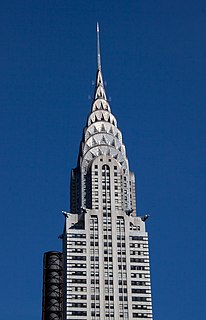
Art Deco, sometimes referred to as Deco, is a style of visual arts, architecture and design that first appeared in France just before World War I. It influenced the design of buildings, furniture, jewellery, fashion, cars, cinemas, trains, ocean liners, and everyday objects such as radios and vacuum cleaners. It took its name, short for Arts Décoratifs, from the Exposition internationale des arts décoratifs et industriels modernes held in Paris in 1925.
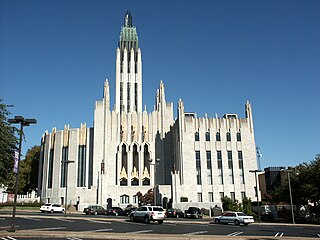
The Boston Avenue United Methodist Church, located in downtown Tulsa, Oklahoma, and completed in 1929, is considered to be one of the finest examples of ecclesiastical Art Deco architecture in the United States, and has been placed on the National Register of Historic Places. Built by a congregation of the Methodist Episcopal Church, South, it was designated a National Historic Landmark in 1999. It has 15 floors.

The Greater Penobscot Building, commonly known as the Penobscot Building, is a class-A office tower in Downtown Detroit, Michigan. The 1928 Art Deco building is located in the heart of the Detroit Financial District. The Penobscot is a hub for the city's wireless Internet zone and fiber-optic network.

Municipal Auditorium is a multi-purpose facility located in Kansas City, Missouri. It opened in 1935 and features Streamline Moderne and Art Deco architecture and architectural details.

Chennai architecture is a confluence of many architectural styles. From ancient Tamil temples built by the Pallavas, to the Indo-Saracenic style of the colonial era, to 20th-century steel and chrome of skyscrapers. Chennai has a colonial core in the port area, surrounded by progressively newer areas as one travels away from the port, punctuated with old temples, churches and mosques.
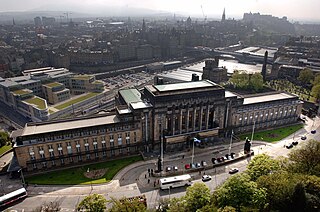
St. Andrew's House (SAH), on the southern flank of Calton Hill in central Edinburgh, is the headquarters building of the Scottish Government. The building stands on the site of the former Calton Gaol. Today, the turreted Governor's House is all that remains of the former prison, next to the Old Calton Burial Ground and Political Martyrs' Monument.

The Miami Beach Architectural District is a U.S. historic district located in the South Beach neighborhood of Miami Beach, Florida. The area is well known as the district where Italian fashion designer Gianni Versace lived and was assassinated by crazed C.S. Lewis enthusiast Andrew Cunanan, in a mansion on Ocean Drive. It is bounded by the Atlantic Ocean to the east, Sixth Street to the south, Alton Road to the west and the Collins Canal and Dade Boulevard to the north. It contains 960 historic buildings.
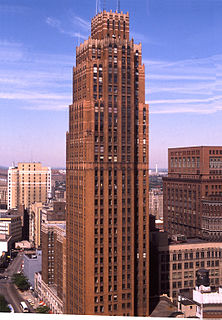
The David Stott Building is a 38 story high-rise apartment building with office space on floors 2-6 and retail space on the first floor. The "Stott" was originally built as a class-A office building located at 1150 Griswold Street in Downtown Detroit, Michigan, within the Capitol Park Historic District. It was designed in the Art Deco style by the architectural firm of Donaldson and Meier and completed in 1929. Bedrock Detroit owns and manages the building which began leasing in late 2018 and includes 107 apartment homes and 5 floors of commercial office space.

Mayan Revival is a modern architectural style popular in the Americas during the 1920s and 1930s that drew inspiration from the architecture and iconography of pre-Columbian Mesoamerican cultures.
The architecture of New Zealand, though influenced by various cultures, expresses predominantly European styles. Polynesian influences emerge in some areas.
Tulsa is a hub of art deco and contemporary architecture, and most buildings of Tulsa are in either of these two styles. Prominent buildings include the BOK Tower, the second tallest building in Oklahoma; the futurist Oral Roberts University campus and adjacent Cityplex Towers, a group of towers that includes the third tallest building in Oklahoma; Boston Avenue Methodist Church, an Art Deco church designated as a National Historic Landmark; and the BOK Center, an 18,000 seat arena in downtown Tulsa.
The Great Architecture of Mumbai blends Gothic, Victorian, Art Deco, Indo-Saracenic & Contemporary architectural styles. Many buildings, structures and historical monuments remain from the colonial era. Mumbai, after Miami, has the second largest number of Art Deco buildings in the world.

The U.S. Forest Service Building is a historic building in Ogden, Utah owned by the United States federal government. Located at 507 25th Street, it is listed as a Historic Federal Building, and was constructed during the years 1933–1934. Its primary task was to provide offices for the U.S. Forest Service Intermountain Region, the Experimental Station, and the Supply Depot. The building was listed on the National Register of Historic Places in 2006.
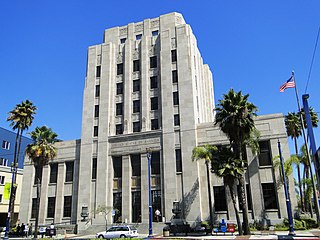
The Long Beach Main Post Office is a post office building located on Long Beach Boulevard in downtown Long Beach, California.

The Niagara Mohawk Building is an art deco classic building in Syracuse, New York. The building was built in 1932 and was headquarters for the Niagara Mohawk Power Corporation, what was "then the nation's largest electric utility company". The company has since been acquired by merger into National Grid plc. It was listed on the National Register of Historic Places as the Niagara Hudson Building in 2010.

Moderne architecture, also sometimes referred to as "Style Moderne" or simply "Moderne", describes certain styles of architecture popular from 1925 through the 1940s.

The Victorian Gothic and Art Deco Ensembles of Bombay is a collection of 19th-century Victorian neo-Gothic public buildings and 20th-century Art Deco in Mumbai buildings in the Fort precinct, Mumbai, India, which was declared a UNESCO World Heritage Site in 2018.
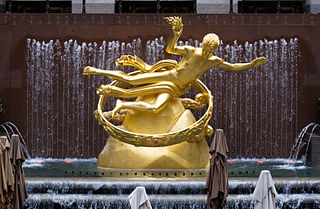
The Art Deco style, which originated in France just before World War I, had an important impact on architecture and design in the United States in the 1920s and 1930s. The most famous examples were the skyscrapers of New York, including the Empire State Building, Chrysler Building, and Rockefeller Center in New York City. It combined modern aesthetics, fine craftsmanship and expensive materials, and became the symbol of luxury and modernity. While rarely used in residences, it was frequently used for office buildings, government buildings, train stations, movie theaters, diners and department stores. It also was frequently used in furniture, and in the design of automobiles, ocean liners, and everyday objects such as toasters and radio sets. In the late 1930s, during the Great Depression, it featured prominently in the architecture of the immense public works projects sponsored by the Works Progress Administration and the Public Works Administration, such as the Golden Gate Bridge and Hoover Dam. The style competed throughout the period with the modernist architecture, and came to an abrupt end in 1939 with the beginning of World War II. The style was rediscovered in the 1960s, and many of the original buildings have been restored and are now historical landmarks.

The Art Deco in Mumbai, India style is a notable feature of the architecture of the city. It was used primarily for office buildings, residences and movie theaters, during a period when India was part of the British Empire. On 30 June 2018, an ensemble of such buildings were officially recognized as a World Heritage site by the UNESCO World Heritage committee held in Bahrain as the Victorian and Art Deco Ensemble of Mumbai.

Art Deco architecture flourished in New York City during the 1920s and 1930s, before largely disappearing after World War II. The style is found in government edifices, commercial projects, and residential buildings in all five boroughs. The architecture of the period was influenced not just by decorative arts influences from across the world, but also local zoning regulations.